
Newsletter of the Shell Club of Sydney
NSW Branch, The Malacological Society of Australasia Limited ACN 067 894 848
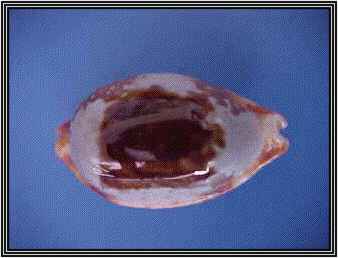 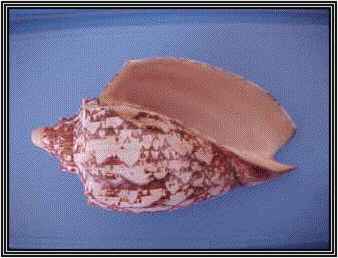
Examples of pictures from a new web site http://caledonia.8m.com
(Photos not for commercial re-use)
Meeting Minutes 27/03/99.
Field Trip Reports P. Jansen reported on a trip to Long Reef, NSW, where many species were observed including a number of Cypraeidae. Patty also mentioned that a group of school children were observed turning rocks looking for sea creatures but unfortunately failed to return many of these rocks to their starting position.
Book Reviews P. Jansen reviewed the latest issue of American Conchologist. Regrettably reporting the passing of internationally acknowledged Conchologist C. M. Burgess on 21/01/99.
General Business F. Mc Camley's offer of a number of rare "Keppel Bay Tidings" magazines, dating back as far as 1962, was gratefully accepted by the group for use as raffle prizes. M. Keats reported that the E.I.S were developing a plan for the Woollahra area, particularly since the discovery of a rare Brachiopod in Parsley Bay.
Presentations P. Jansen gave a slide presentation on habitat and shell form across a number of gastropod families. Patty demonstrated the differences between a muddy Nth Qld coastal environment ( Townsville ), and a rocky reef from central NSW ( Long Reef, Sydney ). Patty presented a large number of slides representing typical mollusc from both types of substrate.
Patty also answered questions put forward by the meeting.
C. Barnes, Secretary
New Web Site:
Caledonian Sea Shells
http://caledonia.8m.com
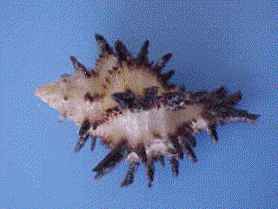
This is a web site focussed on shells from New-Caledonia.
It includes price lists of shells for sale, specialising in New-Caledonian endemics and dredgings in particular. Some of the shells for sale are uncommon and even very rare.
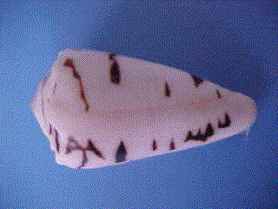
The site is well laid out and interesting. It is not just a sales site.
There is an excellent gallery of shell pictures, thumb-nails with larger images attached. This is changed each month. The 40 or so pictures in this month's gallery are all good quality. A few examples appear on this page and on the front cover. The only down side is that photos in the gallery are not named, other than the image file names. The photos are for viewing pleasure. They are not part of the sales section and not for commercial reuse.
The owner of the site is Vincent Crayssac. He also buys trades and sells rare and uncommon worldwide sea shells.
There is a monthly news article page featuring an unusual shell. There is also a page showing a small number of second hand, hard to come by books, on sale.
One of the most interesting sections in the web site is an auction of "exceptional and unique museum pieces".
This month the auction shows four rare or unique shells graded F++ including a gem grade albino Tigris.
The museum grade pieces are sold using a process whereby interested parties send email messages making offers. I assume the highest bidder over the month gets to purchase the item.
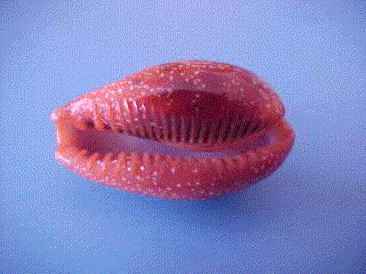
Turbinellidae
Part 14
By Ulrich Knodel
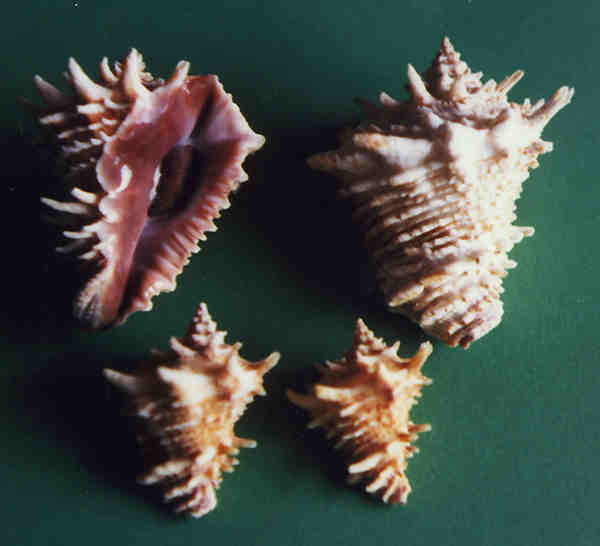
Vasum Cassiforme Kiener, 1841
Syn: Turbinella cassiformis "Valenciennes" Kiener, 1841
Turbinella cassidiformis "Kiener" Deshayes, 1845
The "Helmet Vase" is a rather uncommon to rare species from a small region that is in the State of Bahia, Brazil. The type locality given by Kiener is "Bahia, Brazil".
This beautiful shell is solid and heavy; the usual size is about 65mm. The length of the body whorl (aperture and siphonal canal) is greater than 3 /4 that of the entire shell. The front view show s the aperture with three rather weak columellar folds; the aperture is white inside but with a glossy purple -brown coloured parietal wall. The operculum is very small. The surface of the shell bears about a dozen round cords; 3 - 5 of them near the siphonal canal are a row of smaller spines developed and on the counterpart row near the suture there is to find a row of long developed spines. The periostracum is moderately thick and light - to dark brown.
The species lives in rather quiet water in 5 -510 fathoms. It is reported to be an almost direct descendant of
V. chipolense (an extinct species from the miocene Chipola - Formation of north western Florida, USA).
To obtain a shell for the collection is not exactly cheap but this species is nevertheless frequently on (limited) stock by some larger dealers. A curiosity: "cheaper" and more "easy" to get are the "rare albinos" of this species. I am sure ( ! ) that these albinos exist and perhaps this species may form such pure white shells more than other species. Until now, every one of about 25 specimens examined by me, have had the same appearance: a rough surface, the too rough aperture without the typical gloss (as if the inner aperture was "filed") and of course never with an operculum. I am sure that at least the specimens examined by me, were "hand made albinos". I had the impression that dead eroded shells were offered. The aperture was made white (chemicals? filed?) which was made apparent by the lack of the always present gloss… and some spines gave the impression that they were "incomplete". I must say that none of these specimens were offered from a reliable dealer; I am sure to get a real albino soon and will report about this in a forthcoming work.
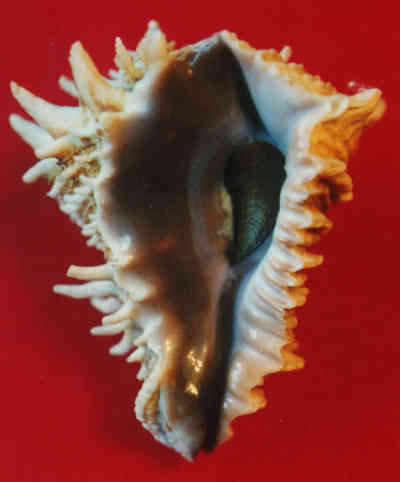
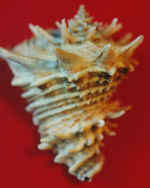
Chicoreus Boucheti,
A superb rarity
By Vincent Crayssac
Example of monthly article from his web site http://caledonia.8m.com/
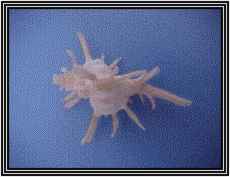
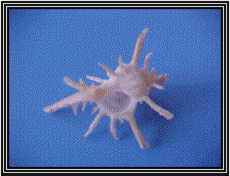
Description:
Shell small for the genus, colour cream with light brown blotches. Some colour variations exist and from our recent dredging we can say that at least two other very different and superb forms exist, a pink form and an albino one.
From our dredging, two albino specimens and 3 pink ones have been found so far, all live taken, with operculum.
The first 3 whorls, the axial costae, the area below the suture and the space between the carinal spines very light cream coloured, almost white; spines and other surfaces light brown.
The aperture is broadly ovate, columellar lip smooth, adherent on its major posterior, barely erected anteriorly.
Anal notch large and moderately deep, well deliminated by small callus. Outer lip erect and denticulate; interior briefly scuptured with 10 small lirations.
Spire high, consisting of one and one-half smooth, rounded nuclear whorls and 5 rounded, slightly angular postnuclear whorls. Suture appressed.
Body whorl bearing 3 varices ornamented with 3 open, upward recurved and barely foliated spines, additional spinelets present between second and third spine, carinal spine longest. Other axial scuplture consisting of 2 moderately strong intervarical costae.
Spiral sculpture of numerous, almost smooth, fine threads. Siphonal canal long, open and dorsally recurved, ornamentated with one upward recurved open spine.
Dimensions: Average size, 28mm x 23mm (spines included)
Type locality: South of New-Caledonia, from 250m up to 480m.
Discussion:
This shell can be compared with only specie: Chicoreus longicornis
(Dunker, 1864).
The new specie differs by the following characteristics: It has 3 open, slightly foliated varical spines,
C.Longicornis has only 2 closed and sharp spines. Furthermore, it has more appressed suture and shows distinct longitudinal striae in the aperture, where
C.Longicornis is smooth.
The protoconchs are almost the same but the ornamentation of the first and second whorls is quite different.
Varice of body world:
Chicoreus Boucheti:
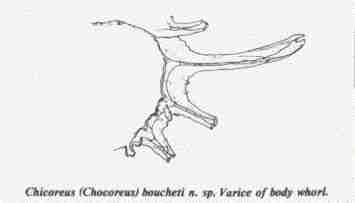
Chicoreus Longicornis:
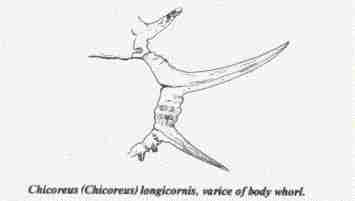
|












